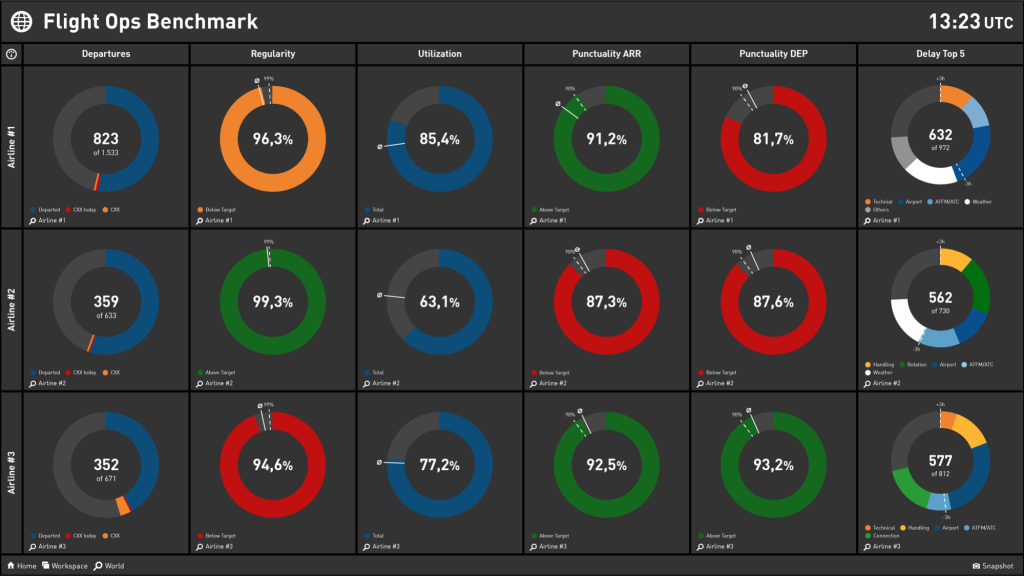Don’t get me wrong: There’s nothing wrong with that. Conversely, we encourage and empower airlines to start tracking those KPIs. Moreover, we help them to monitor in real-time and make KPIs available to relevant stakeholders.
Nonetheless, the world of KPIs is turning fast. And the improvement potential an airline can explore by applying new KPIs or approaches is growing steadily. We are fortunate to be in a position to identify and discuss upcoming trends with clients but also with cooperation partners and technology leaders.
With this blog post, we want to share the knowledge with you and introduce three airline operations KPI trends that will gain increasing importance in 2020.
Airline Operations KPI Trend 1: Temporary KPIs / Dynamic KPI Dashboards
Temporary KPIs are a trend we have been observing over the last months and which has the potential to become a major airline operations trend in 2020.
What’s the idea behind? Temporary KPIs focus on particular aspects. Most often, in the context of an improvement or optimization project. That means the KPIs are set up to prove the success of specific project goals.
Examples we observed: A project that was aiming to reduce the average taxi time at hub or one that aimed to improve the crew readiness. To monitor the success of those projects, corresponding KPIs were created once the projects started and added to available dashboards.
Thus, enabling real-time monitoring of the most critical project goals. Once the projects were completed, and the issue was solved sustainably, the KPIs were removed from dashboards.
Another example are KPIs, where tracking only makes sense during specific periods. One of our clients had huge issues with security control – but only during the summer season. So, they brought a particular KPI to their dashboard to keep track of this process step. Once operations were running smoothly again, the KPI was removed from dashboards.
Dashboards have to transfer from static views to dynamic support tools
From our point of view, the topic of dynamic dashboards will gain more and more importance. Airline operations KPI dashboards will no longer be considered as a static system but have to cope with changing requirements.
The focus during summer peak and winter operations is different. Optimization projects are gaining increasing relevance. And a KPI dashboard should be up to these requirements. That means the content of a KPI dashboard has to change dynamically.
We think there’s a huge potential in turning static dashboards that show the same content day-in and day-out into a combination of most important static KPIs and curated, temporary information and KPIs.
Thus, this trend will enable airlines to enrich operations KPI dashboards with additional value and subsequently help to improve performance further.
Airline Operations KPI Trend 2: Sustainability KPIs
We already discussed this topic in one of our earlier blog posts. Although sustainability cannot be considered as a new trend, it definitely is when it comes to airline operations dashboards.
And during the last months, we’ve observed an increasing demand — at least when it comes to discussing the possibilities of real-time, sustainability KPIs. We are fully aware that these KPIs won’t improve airline operations. They won’t help an airline to become more punctual or to cancel fewer flights.
Nonetheless, given ecological developments and a changing society, we firmly believe that real-time operations dashboards will be enriched with sustainability KPIs sooner or later. We are pretty sure that 2020 will be the year the first airlines will go down that road.
As mentioned in our blog post, we are convinced that visualizing sustainability KPIs in real-time will help airlines to focus on the topic of sustainability and can also be utilized as a sharp marketing instrument.
Airline Operations KPI Trend 3: Benchmarking KPIs
The benchmarking approach certainly is not new. However, when it comes to real-time monitoring of operations KPIs, this approach hasn’t been exploited to its full extent yet (or hasn’t been exploited at all).

In 2019 we set up many aWalls that focus on internal benchmarking — for example, benchmarking the essential KPIs according to different fleet types, different traffic regions, or airline AOCs against each other. When looking into the “2020 glass bowl,” we believe that this approach will – and should – be extended to external data.
Undoubtedly, this approach bears a much higher complexity. Additional data and data sources are needed. Other calculation functionalities are required. Nevertheless, it will be worth the effort from our point of view.
Real-time competitor benchmarking
Just imagine monitoring your OTP in real-time with your most important competitors, comparing your delay minutes ratio at a particular airport with other carriers at that airport. And so on.
This bears a massive potential. Potential to identify weaknesses in comparison with your competitors, but also potential for further improvement measures — and therefore we definitely see this as a huge airline operations trend in 2020.





